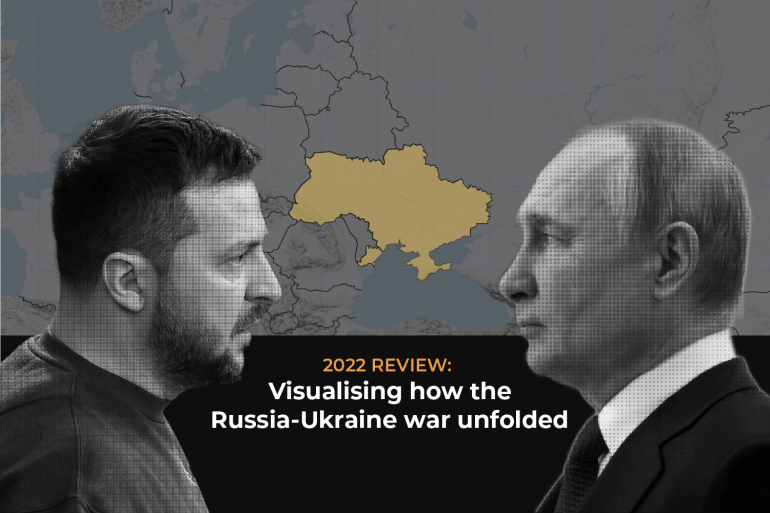2022 review: Visualising how the Russia-Ukraine war unfolded
Al Jazeera looks at how the conflict unfolded on the ground, the human costs of 10 months of war and the global response.

From late February till now, the war in Ukraine has dominated the year’s news agenda like no other story.
Even before Russia’s invasion of its neighbour, months of growing tensions hinted at the risk of a conflict in Europe. But, there was little sense of just how consequential and protracted the fighting would become.
The war has caused tens of thousands of casualties, forced millions from their homes and unleashed a multifaceted global economic crisis.
From battleground gains and losses to mass refugee flows and instrumental weapons supplies, in the maps and charts below Al Jazeera looks at how the war unfolded on the ground, the human costs and global responses.
Taking control on the ground
In late 2021, satellite images emerged showing the buildup of Russian troops on the snowy frontier with Ukraine, raising fears of an invasion. Diplomatic efforts were fruitless and on February 24, Russian President Vladimir Putin in a televised speech announced what he called a “special military operation” to “denazify” and “demilitarise” Ukraine.
People across Europe’s second-largest country woke up to the sound of sirens and explosions as Russian ground forces invaded from four main fronts in the north, northeast, east and south, while artillery and missiles targeted numerous locations.
President Volodymyr Zelenskyy pledged Ukraine will fight back as his government declared martial law and told Ukrainians to take up arms.
In the first month of the war, Russian forces pressed towards Ukraine’s largest cities, including the capital, Kyiv, and the second-largest city of Kharkiv. Moscow’s troops took control of the southern city of Kherson early on, but any Russian aspirations for a swift takeover were stymied by tough Ukrainian resistance.
Bucha, on the outskirts of Kyiv, became a strategic base for Russia’s attempt to advance towards the capital. However, when Russia pulled its troops out of the Kyiv region at the end of March, stating that it would now focus on capturing the eastern Donbas region, evidence of alleged war crimes began to emerge. During a visit to Bucha in April, Karim Khan, the International Criminal Court’s chief prosecutor, described Ukraine as “a crime scene”.
By June, Russia controlled one-fifth of Ukraine, including the southern port city of Mariupol after months of heavy fighting. The front lines largely solidified during mid-year but by early September, Ukrainian forces managed to take advantage of a weaker Russian presence in northeastern Ukraine following the redeployment of Russian fighters to Donetsk and the southern axis, where a Ukrainian offensive in Kherson presented a threat.
The result was a swift counteroffensive that took the Kremlin by surprise and resulted in Ukrainian forces retaking large pockets in Kharkiv province and the town of Izyum – according to the British defence ministry, the retaken territory was at least twice the size of London.
“Within four days, Ukraine nullified four months of success of the Russian army that cost them a huge amount of victims,” Nikolay Mitrokhin, a Russian expert at Germany’s Bremen University, told Al Jazeera.
Putin responded by announcing the annexation of four partially occupied provinces of eastern and southern Ukraine. The move came after voters in Donetsk, Luhansk, Kherson and Zaporizhia backed joining Russia, according to the results of referendums rejected by the government in Kyiv and its Western allies as meaningless and illegal.
Even though Putin declared that Russia had “four new regions”, calling its residents “our citizens forever”, his troops weeks later retreated from the city of Kherson, the first and only regional capital to be captured by Russian forces since the start of the war.
The decision, Russian officials said, was taken to save the lives of Russian soldiers in the face of a Ukrainian counteroffensive and difficulties to keep supply lines to the strategic city open.
-al jazeera







